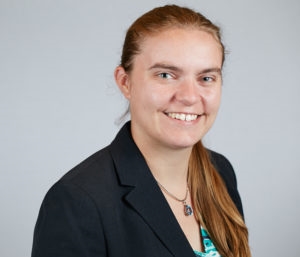Seminar on 'Metal Oxide Semiconductor Nanomaterials' April 18
Professor Kathryn E. Knowles of the University of Rochester will give a seminar titled "Synthesis and Photophysics of First-Row Transition Metal Oxide Semiconductor Nanomaterials" on Zoom from 3:15-4:15 p.m. Monday, April 18. The talk is free and open to the public.
Knowles completed undergraduate studies in chemistry and mathematics at the University of Rochester. She earned a Ph.D. in chemistry from Northwestern University under the direction of professor Emily Weiss with the support of a graduate research fellowship from the U.S. Department of Energy's Office of Science. She worked as a postdoctoral research associate in professor Daniel Gamelin's group at the University of Washington before returning to Rochester as an assistant professor of chemistry in 2016. Throughout her career, Knowles's research has focused on studying inorganic nanomaterials that can convert light to energy in the form of electricity or fuels and characterizing the fundamental photophysical mechanisms that underpin these light conversion processes. Her work has been supported by a DOE Energy Efficiency and Renewable Energy (EERE) Postdoctoral Research Award, an ACS Petroleum Research Fund Doctoral New Investigator Award and a National Science Foundation early CAREER award. She is also a Scialog Fellow for Negative Emissions Sciences.
Metal oxide nanomaterials based on first-row transition metals are particularly attractive for applications in renewable energy technologies for three reasons. They absorb visible light; they are thermodynamically capable of performing desired photoredox chemistry, such as water oxidation and reduction of protons or carbon dioxide; and they are composed of inexpensive, earth-abundant, nontoxic elements. Complete synthetic control of the size, shape and crystal structure of first-row transition metal oxide nanomaterials combined with a thorough understanding of their electrochemical and photophysical behavior is required to optimize their function in photocatalytic applications.
This talk focuses on recent results from two ongoing areas in Knowles' group. The first area investigates the role of organic ligands, solvent and precursor chemistry in controlling the size, shape, composition and crystal phase of first-row transition metal oxide nanocrystals synthesized at elevated pressure using solvothermal methods. The second project combines thermal difference and resonance Raman spectroscopy with DFT calculations to explore the dynamics and electronic structure of photoexcited states of nanostructured thin films of a-Fe2O3 (hematite). These data indicate that polarons (quasiparticles that comprise a charge-carrier self-trapped in a potential well formed by nuclear displacements of the surrounding lattice) form directly upon photoexcitation of a thermally activated lattice. This newly recognized mechanism of photoinduced polaron formation has significant implications for the use of hematite in light-conversion technologies such as photoelectrochemical water oxidation.
To attend the seminar, please visit the Zoom link.
- Meeting ID: 869 7666 6967
- Passcode: Chem$em22
Contacts
Megan Parette, communication specialist
Department of Chemistry and Biochemistry
479-575-4601, mbparett@uark.edu
